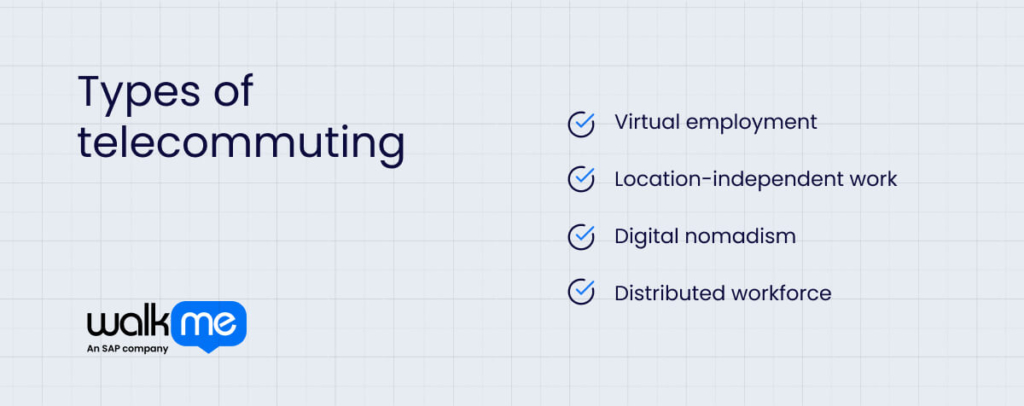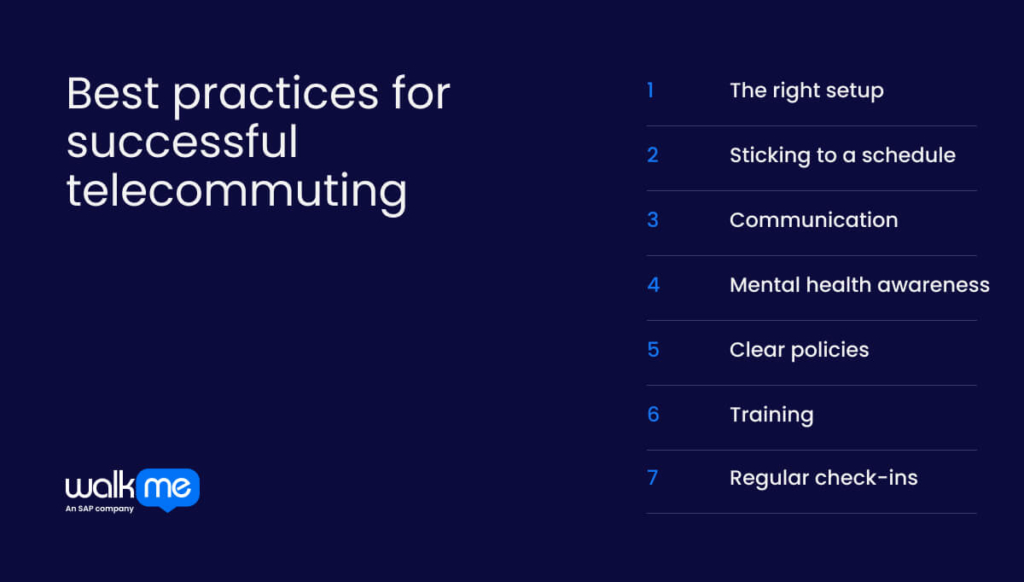The way we work is changing fast, with more people working from home or other places outside the office.
This is called telecommuting. It’s become a big part of modern work life. As our world becomes increasingly digitalized, understanding telecommuting is key to success in the contemporary workplace.
You’ll find useful information here if you’re new to working from home or have been doing it for years.
This guide will tell you all about telecommuting. We’ll cover what it is, why it matters, and how it affects both workers and companies. We’ll also look at real-world examples and share tips for making telecommuting work well.
Telecommuting definition
Telecommuting is working remotely using digital technology to connect with the office.
However, it’s also known by other terms. Let’s take a closer look at the nuances:
Telecommuting
Telecommuting is working from a location outside the traditional office, typically from home, using technology to communicate with colleagues and complete tasks. It allows employees to avoid commuting to a central workplace while fulfilling their responsibilities.
Telecommuter
A telecommuter is an employee who works remotely, often from home, instead of traveling to a central office location. Telecommuters use various technologies, such as computers, phones, and internet connections, to perform their job duties and stay connected with their team.
Telework
Telework refers to any work outside the conventional office using information and communication technologies. It encompasses a range of flexible work arrangements, including working from home, satellite offices, or other remote locations.
Work from Home (WFH)
WFH describes a work arrangement where employees perform their duties from their residence rather than a company office. This setup has gained popularity due to technological advancements and changing workplace norms, especially in light of recent global events.
Remote work
Remote work is a broad term for any work outside a traditional office environment, including working from home, coffee shops, coworking spaces, or traveling. It emphasizes the ability to work from anywhere, often leveraging digital tools and internet connectivity to collaborate with team members and complete tasks.
Why is telecommuting important?
Working from home has become a vital option for many in the modern world, transforming how businesses operate and how employees balance their lives.
It offers workers more flexibility, allowing them to choose when and where they work, improving work-life balance and job satisfaction.
It reduces costs related to office space, utilities, and supplies, with some businesses going fully remote.
Global Workplace Analytics found that if eligible workers telecommuted half-time, it would be equivalent to removing 600,000 cars from roads for a year.
Telecommuting also enables companies to hire globally, expanding their talent pool.
Many studies show telecommuters are often more productive. Stanford University research found remote workers were 13% more productive, took fewer sick days, and had shorter breaks than office-based employees.
Types of telecommuting

Modern work environments have evolved to accommodate various forms of remote and flexible arrangements.
These telework options offer different levels of location independence and work-life integration, catering to diverse employee needs and organizational structures:
Virtual employment
Virtual employment refers to jobs that are performed entirely online, without the need for a physical workplace.
Virtual employees can work from anywhere with a reliable internet connection, using digital tools for communication, collaboration, and task management. This model often involves a high degree of autonomy and self-management.
Virtual jobs can be full-time positions with a single employer or involve freelance or contract work for multiple clients. This arrangement is common in IT, customer service, content creation, and online education.
Location-independent work
Location-independent work, often called “work from anywhere,” allows employees to perform their duties from anywhere.
This arrangement goes beyond traditional telecommuting by offering complete geographical freedom. Workers might operate from home, co-working spaces, cafes, or while traveling.
This model is particularly popular among digital professionals, consultants, and creatives. It requires a high level of self-motivation and excellent time management skills.
Digital nomadism
Digital nomadism is a lifestyle that combines remote work with travel. Digital nomads leverage technology to perform their job duties while continuously traveling to different locations, often internationally.
This approach appeals to those seeking cultural experiences and adventure alongside their careers. Digital nomads typically work in software development, writing, design, or online marketing.
Their work arrangements can vary from full-time employment with flexible companies to freelancing or running their own online businesses.
Distributed workforce
A distributed workforce model involves employees working from various locations rather than a central office. This can include remote workers, telecommuters, and office-based staff.
Companies adopting this model often have multiple smaller offices or hubs in different regions or countries, complemented by home-based workers.
This approach allows businesses to tap into diverse talent pools, operate across different time zones, and reduce overhead costs associated with large central offices.
Effective management of a distributed workforce requires robust communication tools, clear processes, and a strong company culture that fosters cohesion despite physical distance.
Use cases for telecommuting
Telecommuting can be applied in many different job roles and industries. Here are some common use cases:
Software development
Software development is one field in which telecommuting is very common. Programmers can write code from anywhere with a computer and internet connection. They use tools like GitHub to share code and work together on projects. Many tech companies have embraced remote work for their development teams.
Customer experience
Customer experience is another area where telecommuting works well. Many call center jobs can be done from home. Workers use special software to take calls and help customers. Companies like American Express and Amazon have large remote customer service teams.
Writing and editing
Writing and editing jobs are also well-suited to telecommuting. Journalists, content writers, and editors can work from anywhere. They use email and online tools to communicate with sources and submit their work. Many newspapers and online publications have remote writers on staff.
Graphic design
Graphic design is another field in which many people work remotely. Designers can create logos, websites, and other visual content from home. They use design software and file-sharing tools to collaborate with clients and colleagues.
Healthcare
Some healthcare jobs can even be done through telecommuting. Telemedicine allows doctors to consult with patients via video calls. It’s especially useful for follow-up appointments and managing chronic conditions.
Sales
Sales roles can also be done remotely. Many salespeople now use phone calls, emails, and video meetings to connect with clients instead of traveling for in-person meetings, which can save time and money on travel costs.
These are just a few examples. As technology improves, more types of jobs are becoming suitable for telecommuting.
Best practices for successful telecommuting

Employees and companies must follow certain best practices for telecommuting to work well.
Here are some key tips:
The right setup
For workers, having the right setup is crucial. This means having a dedicated workspace at home, if possible. It should be quiet and free from distractions. Good equipment is also important. This includes a reliable computer, a comfortable chair, and a fast internet connection.
Sticking to a schedule
Sticking to a schedule is another important practice for telecommuters. It’s easy to let work bleed into personal time when working from home. Set regular work hours and stick to them. Take breaks and “clock out” at the end of the day, just like in an office.
Communication
Communication is key when working remotely. Make an effort to stay in touch with coworkers and bosses. Use video calls when possible, as seeing faces can help build better connections. Be clear and prompt in your communication to avoid misunderstandings.
Mental health awareness
It’s also important for remote workers to take care of their mental health. Working from home can be isolating. Make time for social interaction, even if it’s virtual. Some companies organize online social events for remote workers. You can also look for local groups or co-working spaces to meet other remote workers.
Clear policies
Clear policies are essential for companies. These policies should cover expectations for work hours, communication, and productivity. They should also address things like data security and equipment costs. Make sure all employees understand these policies.
Training
Training is another important aspect. Companies should provide training on remote work tools and best practices. This can help employees adapt to working from home more easily. Training managers to lead remote teams effectively is also a good idea.
Regular check-ins
Regular check-ins are important for managing remote workers. This could be daily team meetings or weekly one-on-one calls. These help keep everyone aligned and allow for quick problem-solving.
Companies should also focus on maintaining their culture in a remote environment. This might mean virtual team-building activities or regular all-hands meetings. Some companies send out company swag or care packages to remote workers to help them feel connected.
Telecommuting: A new age of remote work
Telecommuting is changing how we work in big ways. It offers many benefits, like more flexibility for workers and company cost savings.
It also comes with challenges, like the need for self-discipline and new communication methods. As technology keeps improving, telecommuting will likely become even more common.
For workers, telecommuting can mean a better work-life balance and the freedom to live anywhere. It can mean access to a wider talent pool and more resilient operations. However, success with telecommuting requires effort from both sides. Workers must stay motivated and connected, while companies must provide the right tools and support.
As we move forward, the lines between “office work” and “remote work” may blur. Many companies are adopting hybrid models, combining the best of both worlds. The future of work will likely be more flexible and digital than ever.
Whether you’re a worker considering a remote job or a company thinking about offering telecommuting options, it’s important to understand these trends. By embracing the possibilities of telecommuting and following best practices, individuals and organizations can thrive in the changing world of work.
FAQs
While often used interchangeably, teleworking and remote work have subtle differences.
Teleworking typically refers to working from a specific alternative location, often home, while maintaining regular contact with a central office.
Remote work is a broader term encompassing any work done outside a traditional office, potentially from anywhere in the world.
In essence, teleworking is a form of remote work, but not all remote work is considered teleworking.
The main advantages of telecommuting are:
- Increased productivity due to fewer office distractions
- Better work-life balance from flexible scheduling
- Reduced commute time and associated costs
- Lower overhead costs for employers
- Access to a wider talent pool for companies

